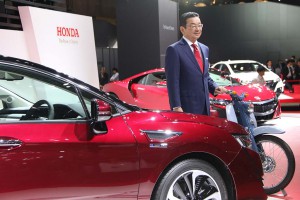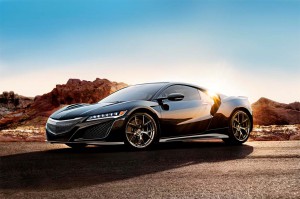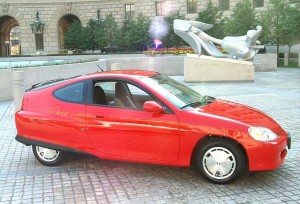Two cars couldn’t seem more unlike one another. Yet the Honda Insight and Acura NSX have a lot in common – and they’re trailblazing the path being laid out by Honda’s new CEO Takahiro Hachigo.
Though one car focuses on fuel economy, the other on performance, both rely on gas-electric hybrid powertrains, Insight and NSX underscoring Honda Motor Co.’s plan to have hydrogen and battery-powered vehicles account for two-thirds of its line-up by 2030. Today, so-called “new-energy” vehicles make up just 5% of the Japanese automaker’s model mix.
“We want to focus our development resources for electrification,” Hachigo said during a Tokyo news conference that marks the start of his second year at the helm of Japan’s third-largest automaker.
(Acura to reveal new 2017 MDX in New York. Click Here for a preview.)
Honda was an earlier player in alternative propulsion, bringing out the original version of the Insight about the same time as Toyota’s Prius. But while the competing hybrid has become the world’s best-selling gas-electric model, neither first nor second-generation Insight models have gained much traction. Indeed, critics both inside and outside Honda feel it has lost its lead in green technology just as the rest of the industry begins to take battery and hydrogen power seriously.
That perception could change with the launch of the reborn Acura NSX. The original proved that a Japanese carmaker could challenge European makers like Porsche and Ferrari at their own game. But Acura is taking a different twist this time. Rather than just stuffing a big engine under the hood of the two-seater, it has adopted a complex drivetrain combining a turbocharged V-6 and three electric motors.
“This is the pinnacle of what we’re trying to do,” Jon Ikeda, the new general manager of the Acura brand, told TheDetroitBureau.com. “The NSX represents what we’re about and what we’re trying to do with mobility globally.”
A modified version of the NSX drivetrain, with a little more emphasis on fuel economy, is expected to be announced at the New York Auto Show next month for use on the luxury brand’s top-seller, the MDX sport-utility vehicle. And, though he wouldn’t confirm that launch, Ikeda hinted that a large share of Acura’s line-up eventually will offer some form of alternative power.
The broader Honda family will offer a mix of different alternative power solutions. In Tokyo, Honda CEO Hachigo announced that the carmaker will launch a plug-in hybrid for the North American market by 2018. And it will then add plug-in versions of its other major models.
(JD Power: vehicle reliability problems worsen. New technology to blame. Click Here for more.)
Plug-in hybrid-electric vehicles allow limited driving – typically 20 to 50 miles per charge – in electric-only mode, with a back-up gas engine to allow the car to keep going when the batteries are discharged. According to Hachigo, PHEVs will be “at the core of electrification in the future” for Honda.
The Japanese maker isn’t alone. General Motors just launched a second-generation Chevrolet Volt plug-in and has plans for other models. Mercedes-Benz has promised to bring 10 PHEVs by 2018, including versions of some of its most important product lines, such as the E-Class sedan and GLE sport-ute.
But Honda has voiced perhaps the most ambitious target, with plug-ins expected to generate fully half of its global sales by 2030, and other electrified models adding another 15%.
What is unclear is how many of those other models will use hydrogen fuel-cell technology to provide current for their electric motor drive system. After an unexpected delay, Honda is finally getting ready to launch its new Clarity Fuel-Cell Vehicle, one of three hydrogen cars that will be offered to retail buyers by the end of this year.
Recent reports have suggested that Honda is considering a joint venture with GM to build fuel-cell hardware. The two companies declined to comment, but they already have a partnership aimed at developing more advanced hydrogen propulsion systems.
To motivate Honda’s dramatic shift in direction, Hachigo has begun a broad reorganization within Honda. Among other things, Yoshiyuki Matsumoto, the head of automotive operations, will now take over R&D efforts.
That move, explained Hachigo, “is intended to position R&D at the center of all product development, and make it responsible for the design and performance of each and every vehicle.”
(Airbag supplier Takata hid defect from customers, including Honda, Senate panel reveals. Click Here for the story.)



